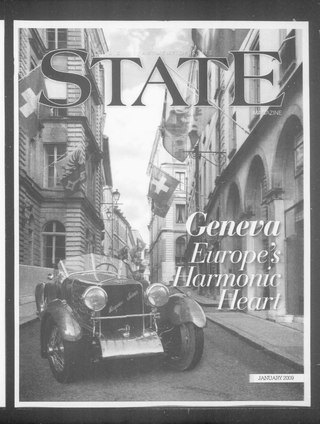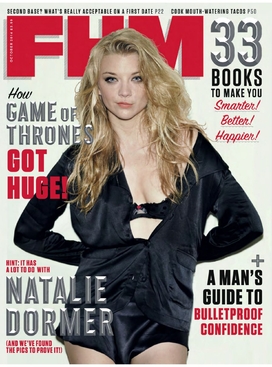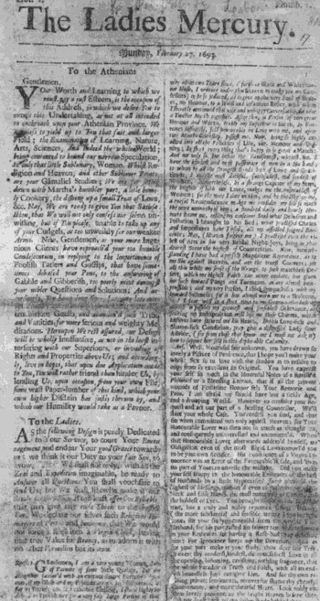
A magazine is a periodical publication, generally published on a regular schedule, containing a variety of content. They are generally financed by advertising, purchase price, prepaid subscriptions, or by a combination of the three.

Isabella Mary Beeton, known as Mrs Beeton, was an English journalist, editor and writer. Her name is particularly associated with her first book, the 1861 work Mrs Beeton's Book of Household Management. She was born in London and, after schooling in Islington, north London, and Heidelberg, Germany, she married Samuel Orchart Beeton, an ambitious publisher and magazine editor.

FHM is a British multinational men's lifestyle magazine that was published in several countries. It contained features such as the FHM 100 Sexiest Women in the World, which featured models, actresses, musicians, TV presenters, and reality stars.

Godey's Lady's Book, alternatively known as Godey's Magazine and Lady's Book, was an American women's magazine that was published in Philadelphia from 1830 to 1878. It was the most widely circulated magazine in the period before the Civil War. Its circulation rose from 70,000 in the 1840s to 150,000 in 1860. In the 1860s Godey's considered itself the "queen of monthlies".

Christianity Today is an evangelical Christian media magazine founded in 1956 by Billy Graham. It is published by Christianity Today International based in Carol Stream, Illinois. The Washington Post calls Christianity Today "evangelicalism's flagship magazine". The New York Times describes it as a "mainstream evangelical magazine". On August 4, 2022, Russell D. Moore—notable for denouncing and leaving the leadership of the Southern Baptist Convention—was named the incoming Christianity Today Editor-in-Chief.
Mary Louise Poovey is an American cultural historian and literary critic whose work focuses on the Victorian Era. She is currently Samuel Rudin University Professor in the Humanities at New York University, and Director of the Institute for the History of the Production of Knowledge. Poovey has taught at Johns Hopkins University, Swarthmore College, and Yale University.

The Delineator was an American women's magazine of the late 19th and early 20th centuries, founded by the Butterick Publishing Company in 1869 under the name The Metropolitan Monthly. Its name was changed in 1875. The magazine was published on a monthly basis in New York City. In November 1926, under the editorship of Mrs. William Brown Meloney, it absorbed The Designer, founded in 1887 and published by the Standard Fashion Company, a Butterick subsidiary.

A fashion plate is an illustration demonstrating the highlights of fashionable styles of clothing. Traditionally they are rendered through etching, line engraving, or lithograph and then colored by hand. To quote historian James Laver, the best of them tend to "reach a very high degree of aesthetic value."

Shafts was an English feminist magazine produced by Margaret Sibthorp from 1892 until 1899. Initially published weekly and priced at one penny, its themes included votes for women, women's education, and radical attitudes towards vivisection, dress reform, women's control of their sexuality, child care, and vegetarianism.

In literature, a serial is a printing or publishing format by which a single larger work, often a work of narrative fiction, is published in smaller, sequential instalments. The instalments are also known as numbers, parts, fascicules or fascicles, and may be released either as separate publications or within sequential issues of a periodical publication, such as a magazine or newspaper.

The Lady's Monthly Museum; Or, Polite Repository of Amusement and Instruction was an English monthly women's magazine published between 1798 and 1832.

The Ladies' Mercury was a periodical published in London by the Athenian Society notable for being the first periodical in English published and specifically designed for women readers.

La Belle Assemblée was a British women's magazine published from 1806 to 1837, founded by John Bell (1745–1831).

The Englishwoman's Domestic Magazine (EDM) was a monthly magazine which was published between 1852 and 1879. Initially, the periodical was jointly edited by Isabella Mary Beeton and her husband Samuel Orchart Beeton, with Isabella contributing to sections on domestic management, fashion, embroidery and even translations of French novels. Some of her contributions were later collected to form her widely acclaimed Book of Household Management. The editors sought to inform as well as entertain their readers; providing the advice of an 'encouraging friend' and 'cultivation of the mind' alongside serialised fiction, short stories and poetry. More unusually, it also featured patterns for dressmaking.

The Lady's Realm was a British women's magazine published from 1896 until 1914, possibly until 1915. It primarily targeted upper-class readers as well as an aspirational middle-class audience, featuring photographs, poems, fiction, and columns by popular authors such as Marie Corelli, Frances Hodgson Burnett, Jack London, and H. G. Wells. The London Season was regularly covered, with visuals of significant society figures and débutantes appearing. Fashion trends in Paris and London were frequently discussed as well, particularly by its fashion editor Marian Pritchard.

Maria Eliza Rundell was an English writer. Little is known about most of her life, but in 1805, when she was over 60, she sent an unedited collection of recipes and household advice to John Murray, of whose family—owners of the John Murray publishing house—she was a friend. She asked for, and expected, no payment or royalties.

Ada Sarah Ballin was an English author, journalist, editor, and lecturer. She was the editor and proprietor of the magazines Baby, Womanhood and Playtime, and published articles and books on health, child care, and dress reform.
Home Notes was a British monthly women's magazine.

















